Carving Out the Colors of Fall: A Sight for ALL Eyes
Nothing says, “Welcome to Fall” like the glow of a bright orange pumpkin patch: Jack-o-lanterns lined up as far as the EYE can see! Pick out a nice, healthy and robust pumpkin for your Fall Halloween decorations then carve out some family fun by adding your own decorative design to his mug.

There’s lots to keep an EYE on this month, including the little ones, who’ll be trick-or-treating on Monday Oct. 31st. We’ll have our Halloween Safety Tips for you later this month. Please read them, print them out and share them with your neighbors, because VISION plays the biggest role in the safety of all of our children.
Savor Super Sight 365 Days a Year
We’ll be recognizing World Sight Day on October 13th, but at Rand Eye Institute, we remind you that it’s important to have good vision the other 364 days of the year too, so why not set aside time to have a complete vision screening?
If you have cataracts, consider that cataract surgery can help you to live longer. A recent study by The American Academy of Ophthalmology of 1.5 million patients over a 10-year period, found that nearly 30% had a reduced adjusted hazard of mortality, compared with those who did NOT have cataract surgery. That says, in a nutshell, that having cataract surgery can help you to live a longer, more fulfilling life.
Why is that? Cataract surgery improves the patient’s ability to care for themselves. Through better vision, they remain physically and socially active, interact more with friends and family and have an overall better visual experience. You don’t have to live with cataracts, especially when the FDA has approved laser cataract surgery as safe and effective, and it’s here NOW at The Rand Eye Institute. Click here to schedule your evaluation.
All this vision knowledge we share with you, will help you up your Rand EYE-Q, so that you can have a safe and happy fall season.
Healthy Aging – Healthy Habits
Ah, Fall is here! Soon the rain will let up, cooler weather will prevail, the sun will set earlier and holiday decorations will adorn homes and department stores alike. With great vision, you’ll be able to experience the colors and sparkle of the Holidays to come.
As we wrap up September’s Healthy Aging Month, here are some tips to help your vision FALL in line too:
First, find out where your vision stands by scheduling a comprehensive dilated eye exam. The dilated exam differs from the basic eye exam you may have had for glasses or contacts. With a dilated eye exam, the doctor is able to examine the inside of your eyes to detect the early stages of eye disease before vision loss occurs.
Your doctor will be looking for:
- Age-related macular degeneration, which affects the macula, where sharp, central vision is born.
- Cataracts, a clouding of the lens in the eye.
- And Diabetic Retinopathy, a complication of diabetes that damages blood vessels in the retina in the back of the eye.
Spotting these vision issues early is the best way to prevent vision loss. If you are 40-64 years old, you should have a comprehensive dilated eye exam every 2-4 years, if you are 65 or older, every 1-2 years. Anyone with symptoms of eye trouble should see an eye doctor right away.
Fall Into THESE Healthy Habits
Which of these two food choices is best for your vision?

The answer, of course, is “A”. Grapes, along with other foods that are rich in lutein and zeaxanthin, such as kale, spinach, squash, corn and kiwi, contain potent antioxidants that can be beneficial to your eye health in helping prevent eye diseases like macular degeneration.
Foods loaded with vitamin C are also beneficial in helping ward off cataracts, the leading cause of blindness in the world. Vitamin C is a powerful antioxidant. The fluid inside the eyeball is normally high in a compound similar to vitamin C, which helps prevent oxidation that results in a clouded lens. Scientists believe more vitamin C in the diet may increase the amount present around the lens, providing extra protection.
Choose whole grains and cereals. They contain fiber, which slows down digestion and the absorption of sugars and starches, while sugars and refined white flours may increase your risk of age-related eye diseases.
Healthy Fat may sound like an oxymoron but it can help prevent dry eyes
Omega-3 essential fatty acids can help the function of the meibomian oil glands in the eyelids, which creates a layer of oil floating on the tear film, which reduces the evaporation rate. Omega-3’s are found in fish, flaxseed oil, walnuts and canola oil.
Stop smoking. Smoking is as bad for your eyes as it is for the rest of your body. It increases your risk for age-related macular degeneration, cataracts and other eye diseases and conditions that can damage the optic nerve. Stopping isn’t easy, but it’s well worth it.
Wear a hat and sunglasses outdoors. Choose sunglasses that block 99 to 100 % of UV-A and UV-B radiation. This simple step, along with proper hydration, including water, vegetable and fruit juices are beneficial for your overall health and eye health.
Healthy Aging – Vision Tips
The phrase “See you in September” has special meaning for us. Of course we’re happy to see you all year long, but September is designated as Healthy Aging Month, so here are some ways to keep your eyes healthy, so that we can see you every month of the year.
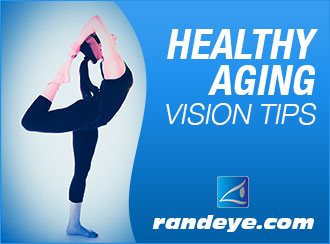
Move or Lose (Sight of) It
Probably THE most helpful tip to healthy aging is staying healthy. While we know that keeping your body moving is good for your physical wellbeing, it’s also good for your vision. The American Academy of Ophthalmology reveals that regular exercise helps keep our weight in the normal range, reducing the risk of diabetes and diabetic retinopathy. This includes gentler exercise like walking, yoga, tai chi, stretching and breathing. So come on feet, start walkin’.
The Best Veggies for Best Vision
Eating your vegetables, especially carrots, is not just a fable; they really do contribute to healthy vision. The vitamins in carrots and other brightly colored vegetables help keep your eyes healthy and your vision strong with the antioxidants they provide. Lutein and zeaxanthin are two potent antioxidants that studies have shown can help prevent eye diseases like macular degeneration. So it turns out mom was right all along.
Stay Focused on Eye Health
As you age, be aware of the warning signs of age-related eye health problems that could cause vision loss. Since many eye diseases have no early symptoms, you may not notice the changes to your vision until the condition is quite advanced. While you may realize that although glucose is an important source of energy for the body’s cells, TOO MUCH glucose in the blood can cause damage to many parts of the body, including the heart, kidneys, blood vessels and the small blood vessels in the eyes. The American Academy of Ophthalmology shows how this could lead to Diabetic Retinopathy. Regular eye exams offer early detection of disease and can significantly improve your chances of maintaining good eye-health as you age.
Give a Little & Get More Back
It feels good to give and it’s good for you. Volunteering can take on many forms, such as teaching, nursing or childcare. Consider supporting a local symphony by ticket taking at the door, helping your church or synagogue at an event, singing in the choir, answering phones at a non-profit or mentoring someone. What does this have to do with healthy vision? Research shows that volunteering also contributes to good health. The results of more than 30 studies show that older people who volunteer enjoy longer lives, function at a higher level and have lower rates of depression and heart disease. So whatever cause gets YOUR blood pumping, it’s the cause to an effect: better overall health and that means healthier eyes too.
Healthy Aging Month
It’s Healthy Aging Month, and because your future is so bright-here are some Rand EYE-deas and tips to keep your mind healthy too.
Of course, exercise fires up endorphins, which stimulate your mind, but exercising your intellectual skills, works out the muscles in your brain to keep them firing on all cylinders too.
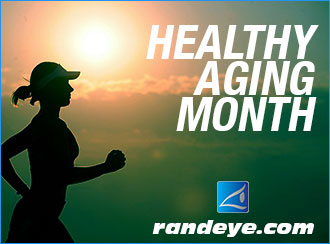
You Have Built-in Windows
Since your eyes are the windows to the world, expand your mind, pick up a crossword puzzle, do a brain-teaser or watch Jeopardy (we seem to know every answer when we watch at home, LOL). If you look online, you’ll “discover” websites that offer free puzzles, some you can create and print yourself. Consider making a puzzle using the memories of your life and then testing a family member or friend.
The Eyes Have It
Other eye-popping ways to keep a healthy mind might be to engage in a hobby that gives you the chance to use steady hand-eye coordination, like building a model or painting. Here’s another Eye-dea: Look for an inexpensive digital camera. Start shooting. You might become the next Iconic photographer. Remember, digital photographs are free of developing fees and are easy to share on social media.
Imagine This…
You can always get one-up on your health by making a spiritual connection to your inner self. Take a yoga class or try meditation. You’ll see yourself in many new ways you’ve never imagined. Breathe, exhale and find your focal point.
Healthy Aging Month is all about expanding your sense of purpose and giving more meaning to your days ahead. Let our eyes and mind connect to a healthier you!
Next time, we’ll talk about some fun ways to stay healthy with friends and family.
Children’s Eye Health – Sports Eye Safety
Go Team, Go! Back to School!
It’s time to welcome the kids back to school and Rand Eye Institute is on your team with information during Children’s Eye Health and Safety Month. There are an estimated 42,000 sports-related eye injuries each year and the majority of them happen to children.
We all remember being a kid. The excitement of after-school sports and heading outside of the classroom can seem so urgent and important to an active child. Of course it is, but please be sure that your children don’t hit the field, court, diamond or swimming pool without proper eye protection. It really makes a difference.
Because eye injuries are one of the leading causes of vision loss in children, make sure your children always:
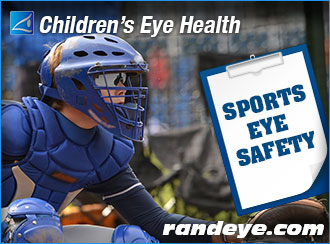
- Wear protective eyewear while participating in sports and recreational activities.
- Play with age-appropriate toys. Make sure your children avoid toys with sharp protruding parts or any flying or broken pieces that could end up in their eyes. If they’re carrying sharp objects, always point them to the ground.
- Wear approved goggles when swimming, even in pools. Chlorine helps reduce water-borne bacteria and viruses, but can also wash away the tear film that acts as a defensive shield for the cornea, leaving swimmers prone to eye infections.
Remember, your children learn from good examples. When you as parents also take precautions to protect YOUR eyes, you’ll SEE the impression it makes on your children.
Count on Rand Eye Institute to give you important facts and reminders about your child’s eye health and safety, especially when it comes to protecting their eyes this back to school season.
Back to School Eye Health – Vision Warning Signs
Summer’s not over just yet, but back to school is just around the corner.
These are formative years for your child, personally and physically. If you have noticed a change in your child’s behavior it may be due to a change in his or her vision.
Below is a list of warning signs. If your child demonstrates any of these symptoms, it is advisable to consult your eye care professional.
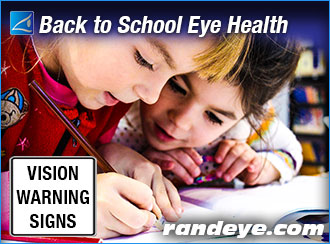
- Child holds reading material too close to face-fourteen to sixteen inches is recommended.
- Child sits too close to TV-eight to ten feet is recommended.
- Complains that writing on classroom blackboard is blurry or too small.
- Missing the ball very often in sports may indicate a problem with vision.
- Child rubs his or her eyes or complains of itching or burning. This could indicate a conjunctival or eyelid problem.
- Child complains of double vision.
- Child points to words while reading.
- Writing words or letters backwards could indicate a problem.
- Child complains of headaches.
- Child skips or misses words while reading.
- Child sees better out of one eye than the other.
- Child complains of pain in or around the eye.
- Poor hand-to-eye coordination.
- Photophobia (bright lights bother eyes).
- Dizziness or nausea.
- Poor concentration while reading.
- Abnormal head tilt while reading.
- Closes or covers one eye to read.
Four out of five children do not receive vision screenings. A screening rarely takes more than an hour and presents no discomfort, but the comfort in knowing that you’ve made your child’s vision a priority, is something YOU should get extra credit for. Call or click today for an appointment because the first school bell is about to ring!
Parent and Child Eye Exams
At Rand Eye Institute, we’ve been sharing helpful tips on getting your kids ready for back to school by reminding you that they should have their vision checked before the school bell rings.

But here’s a good suggestion: Why not make a dual eye exam appointment? Consider having your vision and your child’s vision checked all in one visit, after all, August is “National Eye Exam Month”.
By scheduling a comprehensive eye exam at Rand Eye Institute, you could be heading off future vision problems now, especially if you have diabetes or have a family history of vision problems.
So with vision on our mind this month, keep good vision in the family. Call or “Click” to schedule a dual eye exam* for you and your son or daughter. From our family at Rand Eye Institute, to yours, have a safe Fall season and a successful jump-start to a successful school year.
Know your Rand Eye-Q: Did you know that ophthalmology care is covered under your medical insurance and not your vision plan, this is a common misconception. Please feel free to call us to see if our specialists are participating with your medical insurance.
*A dual eye exam appointment is considered two separate appointments. Ask our appointment specialist for more information when scheduling your appointments.
Back to School Eye Health
While you’re busy with enrollment forms, back-to-school shopping, schedules and immunizations for your child, August is busy being Children’s Eye Health and Safety Month, making it a good time to remind you to get your child’s eyes checked before that first school bell rings.
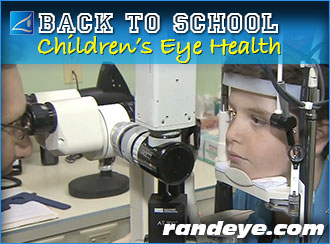
Most children have healthy eyes, but one in four, or 25% of school-aged children either have vision problems or suffer from some degree of visual impairment. What’s more concerning is that The American Academy of Ophthalmology estimates that 80% of preschoolers don’t receive a needed vision screening.
Because they’re young, your children may not have much history with their vision, so what they may perceive as “normal” vision might be something that needs to be addressed, and an eye exam is the best way to find out.
Before you know it, there’ll be homework, school projects, group activities, after-school club meetings and team sports to get them to and from.
So don’t wait for the first bell to ring, have your children’s vision checked now, so they can start the school year off with a clear slate and clear vision.
National Eye Exam Month
At Rand Eye Institute, we know how important it is for you to keep up with your Eye-Q, that is, knowledge about your vision and the understanding of how to keep yours at its brightest and best.
August is “National Eye Exam Month” and healthy vision starts with an eye exam. The American Academy of Ophthalmology recommends that you have a baseline eye exam at age 40, the time when the early signs of disease or changes in your vision may occur. A baseline screening can help identify signs of eye disease at an early stage, when treatment can have the greatest impact on preserving your vision.
If you’re 65 or older, it’s recommended that you have your eyes checked every year or two for signs of age-related diseases, like glaucoma, age-related macular degeneration and cataracts.
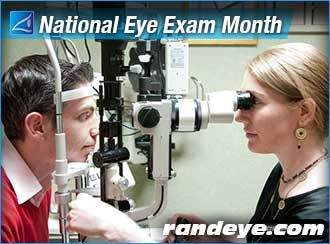
During a dilated eye exam you’ll be checked for the following:
- Medical/family history
- Pupil reaction
- Side/peripheral vision
- Eye movement, muscle balance and coordination
- Focusing ability along with potential refractive errors (myopia, hyperopia, astigmatism, presbyopia) will be evaluated
- Check prescription of eye glasses against new refraction testing
- Eye pressure
- Front part of your eye
- Retina and optic nerve
One of our experienced ophthalmologists will then be checking on the general health of your eye, tracking any disorder that might impair your vision (cataracts, glaucoma, macular degeneration, diabetic retinopathy).
The doctor may suggest additional testing to further evaluate your vision using specialized testing equipment. These tests can be crucial in diagnosing a disease in its early stages and give the doctor an opportunity to suggest a treatment or cure. We are strong advocates of prevention through early detection.
To schedule a comprehensive eye exam, call us at 954-782-1700 and select the “appointment specialist” prompt, or to fill out our convenient appointment request form Click Here. We look forward to seeing you at the Rand Eye Institute, offering Excellence in Ophthalmology.
Greatest Benefit You Get From Your Vision
It’s Senior Independence Month, and how well you see can make a world of difference in your level of independence.
What is the Greatest Benefit You Get From Your Vision?
Is it socializing with friends? Playing cards or doing needlepoint? Driving, or perhaps driving at night? How about seeing your grandkids? That might be everyone’s favorite.

All of these are fantastic reasons for wanting crystal clear vision, because the quality of your vision is directly related to your enjoyment of life and being more independent. Rand Eye Institute offers many vision options to bring back the independence as experienced back in the days of your youth.
Take a Fresh Look at Cataract Surgery
Cataracts are the leading cause of vision loss in adults 55 and over. A cataract is a clouding of the natural lens inside the eye. After the clouding of the eye, normal activities such as reading, gardening, golf or driving can become difficult.
But there’s good news! Rand Eye Institute offers modern cataract surgery, a simple, painless outpatient procedure to regain your vision, if no other diseases are found in the eye, other than the cataract, there’s a better than 98% probability that your vision will be comparable to what you enjoyed at childhood.
Cataract surgery at Rand Eye Institute is easy and virtually pain-free, and usually takes only 20 to 30 minutes or less, returning you to your normal activities the very next day, you know, those activities like golf, driving and seeing your grandkids!
